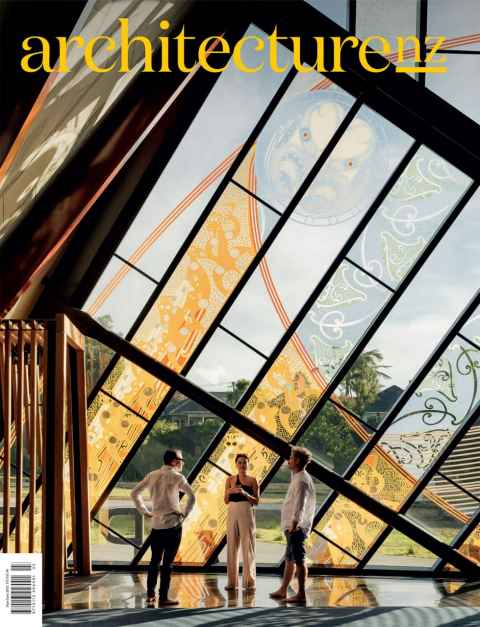Architecture that embodies mātauranga Māori
12 June 2023
Deidre Brown tells the story of a special building, Taumata o Kupe, recently launched at Te Mahurehure Marae.

Ka mimiti ngā puno o Hokianga, ka totō ngā puna o Taumārere. Ka mimiti ngā puna o Taumārere, ka totō ngā puna o Hokianga.
Should the springs of Hokianga run dry, the springs of Taumārere will flow. Should the springs of Taumārere run dry, the springs of Hokianga will flow.
The stories, experiences and learnings of ngā haerenga, the journeys, across sea and land in ancestral and more recent times, are important parts of mātauranga Māori (Māori knowledge).
Taumata o Kupe on Te Mahurehure Marae in Point Chevalier, Tāmaki Makaurau (Auckland), designed by TOA Architects, is a building dedicated to the sharing of mātauranga Māori and to embodying the epic journeys of Māori ancestors across the Pacific and within Aotearoa.
Te Mahurehure is a Ngāpuhi hapū (subtribe) from Waimā in the Hokianga region. Like many other Māori communities since the end of the Second World War, Te Mahurehure has experienced a diaspora of some of its members to Tāmaki Makaurau. Mid-20th-century Māori migrants to Tāmaki Makaurau searched for places to maintain their cultural identity in a city where non-Māori were and still are the majority of the population.
The Māori Community Centre in Freemans Bay was established for this purpose in 1947, occupying a building formerly used by the American Armed Forces and providing an important social venue for generations of urban Māori until the end of the century. Although the building was demolished in 2002, it had already inspired many iwi and hapū resident in Tāmaki Makaurau to prepare their own marae. Ngāti Whātua carved the whakairo rākau (wood carvings) for its marae at Ōrākei here and Te Mahurehure began to look for its own place of belonging, based on the Māori Community Centre model.

The story of Te Mahurehure Marae from its establishment to the construction of Taumata o Kupe is one of hard work and determination. If you ever attend a hui or other event there, you may be fortunate to hear the Marae Chairperson Christine Panapa welcome you with a kōrero about the marae’s 50-year history. That journey started in January 1969, when her father raised a mortgage to buy the site behind her aunt’s Point Chevalier house, which was then a rugby field and clubhouse – described by Panapa as “an old tin shed with a sawdust floor”– accessed down a right of way off a quiet street of postwar starter homes and state housing.
Te Mahurehure Cultural Marae Society was established and set to work paying the mortgage within five years, using funds raised through cake stalls, Housie (Bingo), sporting fixtures on the field, and events held in the clubhouse and other locations. High-profile entertainers, including Prince Tui Teka, the Volcanics, Bunny Walters and the Yandall Sisters, performed in a regular schedule of social evenings hosted by the Society. Fund-raising has ceaselessly continued to support the marae’s development, which included the construction of a large whare kai and events centre, opened in 2009.
Many Māori in Tāmaki Makaurau and beyond have incredibly fond memories of the marae as a place of manaakitanga (hospitality, kindness, generosity and support).
The inspiration for Taumata o Kupe originated from a discussion between the marae’s kaumātua – Christine and her husband John Panapa, Tā Patu Hohepa, Rereata Makiha and Julian Wilcox – about the need for a forum to communicate oral rather than written Māori histories.
This would be a place where people could recite and receive mātauranga Māori, particularly that associated with Kupe, the legendary Polynesian navigator and explorer acknowledged by some iwi as the discoverer of Aotearoa.
The marae commissioned TOA Architects, a Māori-led practice that works across a range of project types, to realise the vision. A member of my whānau (family) was one of the architects and it is through this connection that I have seen the project develop, from design to opening and, now, use. Indeed, Taumata o Kupe was the venue for the inaugural stakeholder hui of MĀPIHI, the new Waipapa Taumata Rau University of Auckland Māori and Pacific Housing Research Centre, which I codirect with Dr Karamia Müller.
Covid-19 struck soon after construction began. Nevertheless, the project resolutely continued navigating lockdowns, supply-chain disruptions and a change in the main contractor. On more than one occasion, I have heard the challenges faced in the construction of Taumata o Kupe likened to those faced by the building’s tipuna (ancestor) on his journey to Aotearoa.
Being resilient is a characteristic of marae and, whenever the pandemic interrupted work on Taumata o Kupe, the neighbouring whare kai would spring into action making and distributing prepared meals for families hit hardest by Covid.
ORGANIC FORM
Taumata o Kupe opened on 12 November 2022 with a dawn ceremony attended by 300 people, including several prominent Māori leaders and politicians.
The building’s sweeping, organic form embodies the dynamism of Kupe’s waka as it sailed towards Aotearoa, according to TOA’s founding director Nicholas Dalton. He describes the glazing as being like a sail with the reflection of the shifting sun and clouds making the building appear to move like a waka across the ocean.
The diagonal black wind brace on the front façade follows the form of stays used on Māori sails, and the glass’ inward tilt and angles on the red barge suggest the movement of sails and rudders. Elevating the structure on a platform makes the building appear to hover. This is a direct reference to the Society Islands’ taumata from which Kupe departed; it is one of many raised stone platforms built across eastern Polynesia where priestly experts shared knowledge.
Entry to Taumata o Kupe is through a long waharoa (entry) formed from a series of timbers milled from 3500-year-old Northland swamp kauri. Suspended within the waharoa is a pare (lintel) carved by tohunga whakairo (master carver) Bernard Makoare. Inside, the ground floor represents the terrestrial world, and its clear space can be reconfigured to accommodate events for up to 300 people. This is a place where tapu (the sacred, prohibited, restricted) and noa (free from tapu) can coexist for hui, with refreshments served from a kitchenette (the whare paku [ablution block] is a separate neighbouring building).
The glazed back wall opens onto a generous deck that overlooks the Waitītiko awa (also known today as Meola Creek) and a backdrop of mature native ngahere (forest) planted by the marae over many years. A mezzanine floor above is associated with the celestial world and provides a second meeting area for communicating tapu knowledge and a space for noho (overnight stays).
One of the striking features of Taumata o Kupe is the multicoloured patterned glass panels on the front and back of the building, designed by TOA Architects’ Matekitātahi Rāwiri. Developed from mātauranga shared with him by the marae’s tohunga Rereata Makiha, the patterns illustrate Kupe’s journey. Rāwiri based his visual language on the traditions of whakairo rākau and kōwhaiwhai (scroll painting) and the contemporary aesthetic and colour palette pioneered by the Māori modernist artist, Cliff Whiting. No stranger to Te Mahurehure Marae, Rāwiri , as a child, attended the marae’s Hinehou Kōhanga Reo, which was housed in a building designed by his mother Tere Insley, the first Māori woman registered architect.
FOUNDATION STORIES
In many wharenui (meeting houses), the whakairo rākau, kōwhaiwhai, tukutuku (lattice wall panels) and, sometimes, murals illustrate the founding stories of the marae and its ancestors, to which kaikōrero (orators) refer in their formal speeches and wānanga.
The same relationship between architecture, oratory and learning is enabled in the window and wall treatments and in the lighting array arranged to represent the star positions during Matariki.
The redevelopment of Te Mahurehure Marae has not stopped with Taumata o Kupe: Te Kāinga Atawhai, a 14-home papakāinga (housing community), will open soon; Hinehou Kōhanga Reo has been moved to the side of Taumata o Kupe and renovated to become a whare hui (meeting building); and, between the two buildings, four double-storey Wāhi Mahi will be built to house toi Māori (with artists in residence living upstairs and working downstairs) and services to support the papakāinga, marae and wider community. TOA Architects has designed all of these projects.
Journeys do not end by simply arriving at a place. From the moment of arrival, new journeys begin to re-establish lives and reinforce connections.
Taumata o Kupe’s architecture represents many haerenga (journeys): Kupe’s journey across the Pacific and that followed by the ancestors of Māori; the migration journey of some members of Te Mahurehure from Waimā to Tāmaki Makaurau; the journey to establish a new marae and reconnect communities; and the journey to design and build a new, innovative and inspiring whare.
Professor Deidre Brown is co-director of MĀPIHI: Māori and Pacific Housing Research Centre, a University research centre hosted in the Faculty of Creatives Arts and Industries at Waipapa Taumata Rau, University of Auckland.
This article is republished with permission from Architecture New Zealand as part of the ongoing series of articles in Mātātaki| The Challenge.